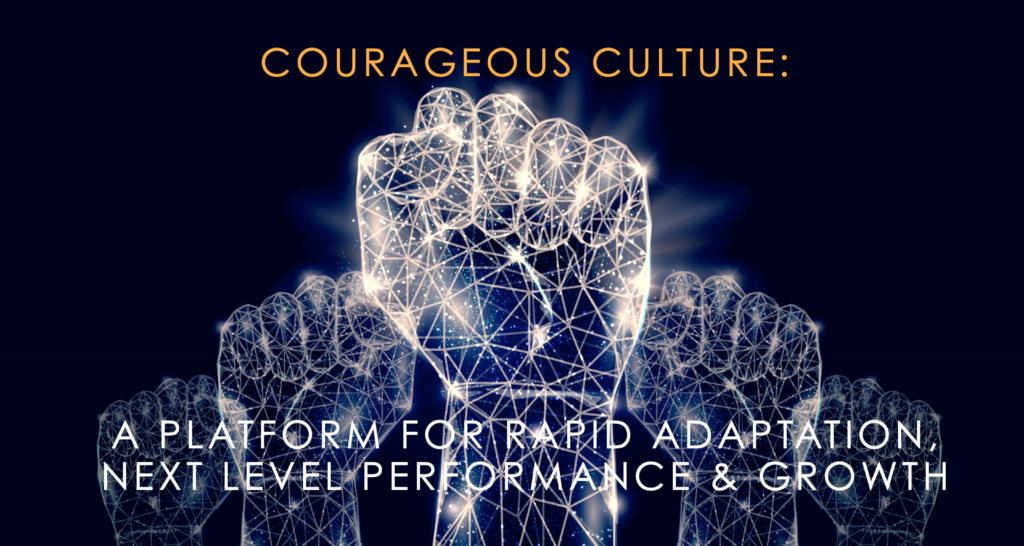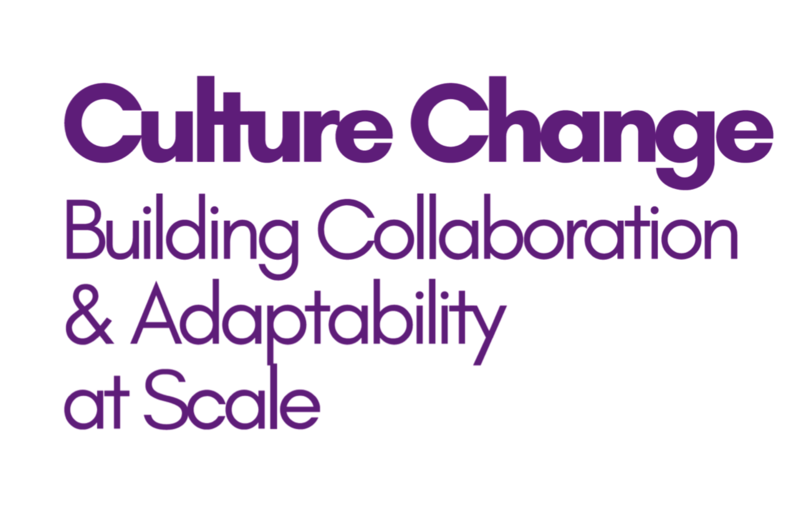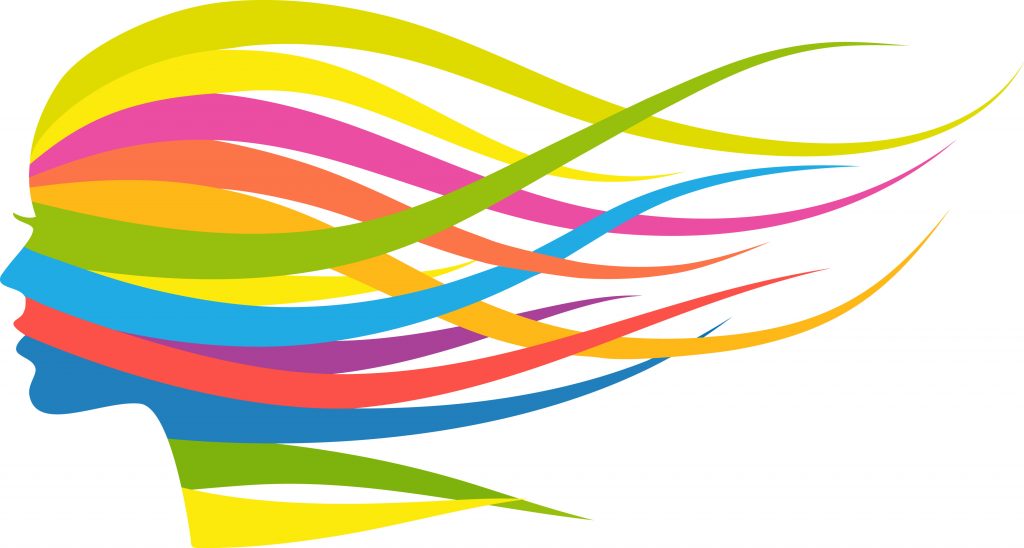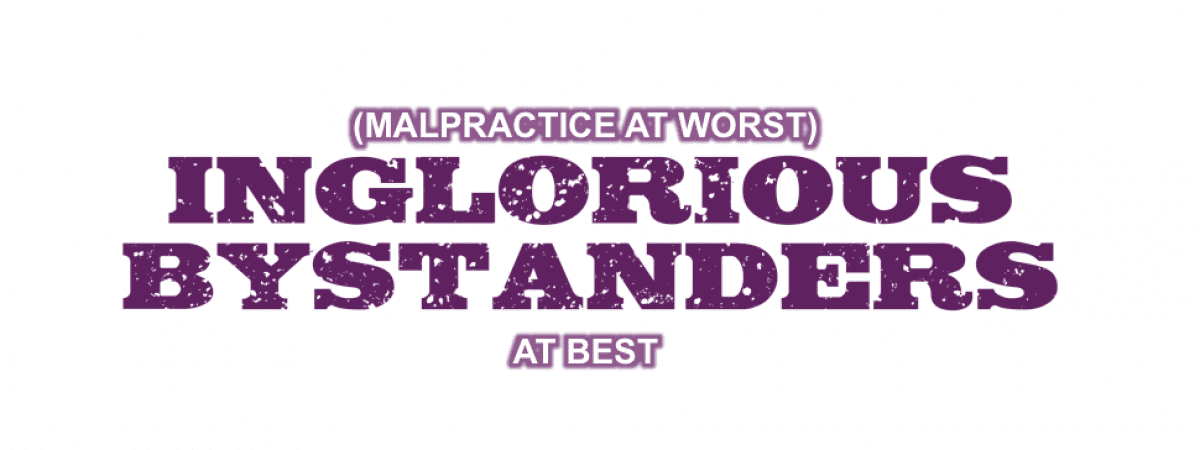
CXO you are, after all, known as a courageous individual & the culture is a reflection of the leadership (past and present).
Years of expertly-executed reorganizing and cost cutting have recently been exchanged for retooling and future-proofing the company against disruption, uncertainty and change. An increased ability to anticipate, adapt and respond more quickly will drive greater advantage for the organization, keep us healthy and strong for the road ahead.
“WE’RE SAYING & DOING A LOT RE: CHANGE/TRANSFORMATION”
For many months, the board and the CEO have been focused on a more generative and healthier balance of efficiency, velocity, flexibility, long-termism, sustainabla-bla-bla results, strengthening core yada-yada values, human capitabla-bla and clarity of purpose + profit bla-bla-bla. (Even if you believe in these “buzz words” – we all recognize that they can be a trigger/distraction.)

The organization is DOING a lot in the name of change with regard to strategy, vision and business process. And your company has already invested millions in new product development/innovation, agile processes/structures, office design, change management protocol, new internal communication campaigns and many town halls. You even built beautiful digital centers of excellence.
“BUT STILL, TRANSFORMATION ISN’T HAPPENING FAST ENOUGH”
Meanwhile, new competitors are growing rapidly and creating a significant threat. Despite all the changes you have made, the market is telling you that you are not executing fast enough and the transformation is not happening deeply enough. Your brands and digital channels are growing X times slower than your competitors. Even your newer executives, hired from companies that were “born agile and digital” are experiencing surprising difficulties and unexpected blockages from within the organization.
You strongly believe that the company culture is what’s causing the lag, drag and counterproductive friction. Culture is unintentionally undermining the execution of your growth strategy. The organization is not moving forward in terms of the performance improvements expected by now. Your leadership team wants better results. Accordingly, you committed to your pioneering CEO that you would Transform (with a capital T) your company into a courageous and adaptive, high-performance culture — one that is fully engaged, agile, creative and collaborative…one that is more capable of digital-yadayada, customer-centribla-bla, etc.
“Transformation with a capital T, which we define as an intense, organization-wide program to enhance performance (an earnings improvement of 25 percent or more, for example) and to boost organizational health. When such transformations succeed, they radically improve the important business drivers, such as topline growth, capital productivity, cost efficiency, operational effectiveness, customer satisfaction, and sales excellence.” –Bucy, Hall and Yakola (McKinsey & Co.)
THE BIG “T” RARELY FOLLOWS A “DO AS I SAY” PATH; EVEN THE “DO AS I DO” PATH HAS LIMITS
Your C-suite peers and report directs are likely somewhat cynical about the idea of culture Transformation being successful at your company (and justifiably so) — not because they think you are insincere, but because they are convinced that the system “is what it is.” The system always wins, and the system itself lacks the objectivity to be fixed by the system.

Our traditions are usually stronger than our intentions to change.

Plus when the other execs talk about being on board with fixing the culture with transformation efforts, whether they are aware of it or not, they are likely talking about transformation with a little “t.” In the spirit of Bruce Lee, rather than being in such a hurry to fix it, we’re better off if we first focus on enriching our understanding of it. Most executive teams lack a shared language and understanding of this complex topic. Most HR and change management functions don’t have the expertise to best support the executive team with an effective orientation to the topic let alone help them make a conscious choice about committing (or not) to a strong plan to develop cultural empathy and lead the way. (The strong HR execs that do have the expertise, are often caught in a very tough spot, because they are viewed as part of the system themselves.)
Most executives are unaware of how unaware they are when it comes to leading Transformation and shaping culture. We are often unaware of our own contribution to the very thing we complain about. When it comes to the big “T,” we (leaders) are often the limiting factor. Here is what I mean: Many senior executives and their peers don’t really know how culture works from a socio-technical systems (see image below) standpoint. Most don’t know the difference between organizational culture and climate. Most don’t have a clear understanding of the levers for change, the sequence of steps, the essential versus important, etc. Most don’t have experience experimenting (and learning) with emerging best practices in adult development.
BEING > DOING; BUT MOST EXECUTIVE TEAMS AREN’T READY FOR THAT
You and your peers have earned the benefit of the doubt — that you are sincere about change (+ you have more than enough courageous) — but only you know if you’re serious about the deep (identity) work of Transformation necessary to change your individual and collective BE-ING level.
“Most are not serious about change because it requires senior managers to change their behavior. You know how corporate bosses can be. This is not always a very welcome method. I’ve been kicked out of plenty of boardrooms.” Eric Ries (author of The Lean Startup)
Unlike Mr. Ries, I am actually not advocating that you should (or shouldn’t) be serious about it. (No need to kick me out of your boardroom.) I believe it makes total sense if you’re not ready yet. I believe it depends on your business context and it depends on what you/your system truly value most. If you (and your system) value control, obedience and compliance to old norms – then it is a mistake to promise new standards of courage, collaboration and creativity. It is a mistake to make promises about the big “T” when you are only ready for the little “t.”
How do you know when you are ready? Typically, readiness doesn’t come until you have suffered enough trying to fix it the old way – just focused on the doing & trying harder. Once you are dissatisfied enough with your current-level results, then you are ready to consider expanding the goal beyond executing/DO-ING the little “t” and instead work on the big “T” = the BE-ING. Our biases/norms today cause us to react to change with a disproportionate reliance on the “DOING” (technical domains/hard skills, e.g., technology, behaviors) versus securing the path to value by also focusing on the “BE-ING” (human domains/soft skills, e.g., mindsets and identity). Devaluing serious attention on the human domain (in favor of the technical) has historically been the default protocol for most corporations. To succeed at the big “T”, we need both at full strength; we need to upgrade both.

While you may be pitching the big “T,” the majority of the executive team may only be agreeing to the little “t.” Despite the frustration and burnout, if they are not yet ready to agree to the big “T,” then be patient. They will be ready soon enough. For now, “no” is the second-best answer to “yes.” At least then, you can all make that choice consciously/more deliberately. Again, they will be ready soon enough to choose readiness. Change is a chronic condition. It is persistent and long lasting. There will be plenty more suffering. Eventually, once the suffering becomes too great…those of you that stuck around will collectively be more ready to courageously experiment with the deeper, more effective work of the big “T” together.
It’s not your fault if you’re not collectively ready for the big “T” right now – but nonetheless it is your responsibility.
Here is a sampling of consistent leadership team quotes from executives (in various states of individual readiness) across many different industries:

BLAME, DRAMA AND LACK OF TRUST ARE THE ENEMIES OF RAPID ADAPTATION & COURAGE
Many executive teams approach culture change with the wrong mindset and a limited set of tools. Few ever get to the real work of Transformation.
We often hear root-cause explanations (for why it’s so hard) that sound more like “blame-centric” perspectives and worldviews, suggesting that specific people (e.g., millennials, old-timers) “who just don’t get it” make the culture work difficult. Many of us get too caught up in the drama of focusing on where/who to blame for the lack of progress. The analysts/media will blame the brand (for being exactly what they said it was — sleepy, stuck in the past). The board will blame the C-suite. The C-suite/leadership team blames the board, and now they blame you, the CXO (but not to your face). The leadership team blames each other. The leadership team blames HR. The leadership team and HR blame middle management and their inability to “get with the program.” Middle management blames leadership and their unwillingness to listen. The frontline employees blame their direct manager and the corporate ivory tower. And the suffering continues.
This response is a reflection of the current culture. The culture is a reflection of the current (and past) leadership. This tendency for blame and persecution will only stifle improvement + learning & development efforts and make it even harder. I like to say, if it’s hard for you… then chances are you’re doing it wrong. There is a much more effective response available when the team is ready for it.
INDIVIDUAL COURAGE DOESN’T SCALE. COURAGE IS A TEAM SPORT.
It’s good that you are courageous. Unfortunately, courage doesn’t scale from an individual act. Courage is a group behavior. Individual heroics are distracting and represent a VERY misguided storyline when it comes to building a courageous culture. The reality is that most courageous individuals often appear less courageous when they are working in a low trust environment. Lencioni’s work showed us that when the environment is lacking trust then the consequence is a paralyzing sense of bystander-ing that occurs from a fear of conflict, fear of speaking up and fear of making mistakes, lack of commitment, etc.
Usually, at least one leadership team member (avoiding ownership of the trust issue altogether) will say something out of desperation to bring the focus back to courage like:
“I just want courageous people who will try new things and charge up the hill on their own; I want generals, not soldiers waiting for me to tell them what to do. They should know what to do by now. They’re either soft, they’re lazy, they don’t care or they don’t get it. People need to know we are serious about this transformation. Maybe we should fire some of the cowardly people to make the rest move faster.”

The overwhelming majority of your employees aren’t lazy and they aren’t cowardly. They aren’t stuck; employees do get it. Your employees are delivering on exactly what you/your system still values most. They are actually delivering on the current, unwritten norms of the culture = conformity.
Inside an organization, courage is not something you DO alone.
As the existential, humanistic psychologist/philosopher Rollo Reese May famously said (alongside Viktor Frankl and other major proponents of existential psychotherapy),
“the opposite of courage…is not cowardice; it is conformity”— it is the need to fit in.
Courage, like conformity, has to be the group’s agreed-upon way of BEING – a group identity – for it to be scalable and sustainable.
We have to learn to make courage an act of conformity – not an act of valor.
The expert way to do that, is to learn-by-doing – with the explicit intent of becoming. (check out this multi-dimensional example of “courage as a team sport” illustrated by the SPURS)
So if courage is a team sport, how do we make courage a cultural act of conformity?
Psychological safety is the answer, according to Amy Edmondson research from Harvard. Her work illustrates how great performers who find themselves in fear-based, aggressive-defensive and passive-defensive cultures will likely behave like they are afraid to make mistakes and therefore don’t take risks and don’t pursue learning new things as energetically (or as wide-spread) as courageous cultures. The same employees, once they transfer out of the fear-based environment into a constructive culture, will behave courageously in the face of new challenges and changing circumstances. The same goes for adaptability and agility. Most organizations learn in the long run that it is not simply about DOING courageous/agile stuff; it is about BEING courageous/agile. Transformation with a big “T” is a team sport. Transformation happens more quickly and more deeply in community. Culture = the visible and invisible norms (e.g., systems, symbols, behaviors) of our community. Culture is about learning what it takes to fit in—beyond the poster on the wall and the verbal and nonverbal messages.
BE-ING CURIOUS, BEING CLEAR AND BE-ING CONSISTENT
Culture is about decoding the way we get stuff done, successfully around here – historically, currently and ideally. Leaders have to be crystal clear, aligned and exquisitely consistent about their approach/curiosity to explore those gaps.

Leaders need a reliable, MRI level of detailed visibility into the invisible components of culture (and a simple model) to understand and discuss where you are currently as a culture — and where you want to be in the near future. You need to see clearly where you have anomalies of ideal culture success and current culture gaps. To have an effective culture strategy, you can’t afford to use anecdotes or guess about the gap to be closed. It is easy to check. “Check” means the expert use of qualitative and quantitative tools. “Check” also means ask. Just ask. And your openness to receive the answers matters. Culture isn’t declarative; it’s interrogative. Here’s a line of questioning that I use to check on the awareness, urgency and alignment of executive teams involved in both the big “T” and little “t” imperatives:
I’m curious…you are a year or so into this transformation…how’s it going? What are you most excited about? What are you most concerned about? How are you feeling about the transformation?
- What is the business reason/goal for this transformation? What are the key metrics used to measure degrees of success in the execution of this transformation?
- What are the business consequences of not transforming successfully? On a scale of 1 – 10, how important/urgent is this? What if you don’t intervene and people just do (think, relate, act) as they have been doing to date?
- IDEAL STATE: Do the executives who make up the leadership team have clarity about the ideal culture (vision) you are transforming to? Imagine if you woke up a year from now and find that the vision has come true and your goals have been accomplished. What does that look like? When culture change has taken hold, it makes it a lot easier and more likely to achieve your industry-leading/pioneering performance-level goals. How can you tell? What does that look like/feel like? What is different? What are some key habits and areas of mastery that you are excited about? What are people inside and outside your company saying about it?
- CURRENT STATE: Compared to this ideal, what is missing in the current situation? Do these executives have clarity about the current culture and where you are at now? Do you have individual and collective diagnostic tools? From your perspective, how do people need to perform differently in the next X years in order to transform?
- CULTURE PLAN: Do the executives agree on the gap to close? Do they agree on the plan, priority and sequence to close it? What have you done already? What is keeping you from closing the gap and shifting to the ideal culture? What are the identified blockers/obstacles?
- PERSONAL IMPACT: Why did you raise your hand for this? What matters the most to you? Why? What happens to you (personally) if you don’t accomplish the vision? What happens to the council?
- Does the leadership team have clarity, shared language and understanding about how culture evolves and the impact of history on the current state? Have they identified causal factors (e.g., systems, structures) that are part of the work climate? Do they understand how they reinforce and shape the current culture and what may be levers for change in improvement plans?
- How well does the leadership team embody the ideal cultural attributes? How are they being supported? Are they first going to create a shared learning environment for both the technical and human dimensions of change?
- How many people in the organization, beyond the leadership team, are being impacted by the transformation?
NEW CONVERSATIONS AND PERSPECTIVES ABOUT CULTURE
Senior leaders report culture as being critical to business success. A new approach is needed to support leaders responsible for shaping culture.
- Understand and appreciate the complexity and unique culture perspectives of peers and experts.
- Understand how culture is created and the impact of history on the current state as well as important aspects of the work climate that shape and reinforce the current culture.
- Build a common language for understanding the layers of culture using qualitative and quantitative methods.
- Discover how culture evolves. Identify paths that increase the likelihood of shared learning and positive results with any major change effort.
- Identify causal factors (systems, structures, etc.) that are part of the work climate. Understand how they reinforce the current culture and how they may be levers for change in improvement plans.
It is always amazing to see what is possible when we engage each other in a newly designed dialogue/mutual learning experience. Some very insightful commentary and shifts of perspective take place. Where transformation is the goal, the unit of work is dialogue.
ADDITIONAL EMPATHY AND MOMENTUM
I am always reminded that we (leaders) have a lot to learn about the complexity of culture change efforts and the impact our own leadership has on keeping the status quo (traditions) in place — despite our intentions to lead change. Perhaps in conversations like these, more leaders can begin to see how MAYBE it makes sense that our people are stuck and confused about what to do with regard to culture change because we (the leaders) are stuck and confused too. Usually, that sparks an environment/energy that is more ready than ever to learn how to shift culture more quickly and sustainably.
THREE PART APPROACH TO BUILD A MORE COURAGEOUS CULTURE
The approach and sequence matter. The means is the end.

The idea of the work to be done is simple: test and learn what works (in the context of business) to help deliver better results + build stronger team trust + create stronger sense of individual fulfillment and satisfaction. The details of the execution are complex.

EVERY TRANSFORMATION JOURNEY IS DIFFERENT
It is about engaging with others differently. It is about how we choose to take care of each other while pursuing excellence, together. Here are examples of journeys, shifts and models (used by Axialent) that are most effective at helping high-performance teams build an even more courageous culture inside of multinational organizations.
“BE agile versus DO agile” (Supporting one of the largest AGILE transformation projects in the world.)


“From Bureaucratic to Innovative” (Supporting R&D teams across the world leverage the potential present in the system.)


COURAGEOUS CULTURE IS A LIFESTYLE CHOICE
We can’t BECOME courageous just by deciding to do so any more than we can just BECOME healthy just by deciding to do so. Deciding isn’t the same as being. If everyone could just BE the better, more effective version of ourselves we would. We would all eat healthy, exercise, meditate and stop doing the old counterproductive habits that trip us up. We aren’t lazy, apathetic, lacking discipline or willpower. We all have competing priorities – some we aren’t even consciously aware of. We are all at our own current level – working on our own next level. We are all somewhat socially-defined and self-authoring. We are all social beings. We all need to fit in. Courage is a group behavior & a way of working/BE-ING together. A courageous culture unleashes and amplifies our courage – it expands our capability to learn and adapt.

To win today, high-velocity organizations need to fuel unprecedented learning, awareness, people development, cognitive flexibility, complex problem-solving and impeccable coordination of action (at scale). To sustain it at scale, we need to build deliberately developmental cultures (mutual learning environment vs unilateral control) fostering safe, courageous, high-trust, high engagement, productive conflict/healthy debate, mutual accountability and a focus on results.
How will you help your organization become the kind of culture that is even more courageous, adaptive and agile? We (collectively) have to work on BECOMING that kind of culture over time – becoming an environment where diverse human beings can bring 110% of their grit, energy, intelligence, creativity and courage to bear on the increased challenges that face us all.
Change is a persistent, unstoppable, chronic condition (a 21st-century lifestyle) that we’ll always have to live with & embrace together as a group.
The condition is complex, but the treatment is simple. Do more of what makes you stronger: EQ/Mindsets+AQ/Muscle Building. Prioritize and strengthen the muscle groups that upgrade the culture vs fall victim to our unconscious obedience to current norms.
We’re all always working on culture — we’re either helping it become more adaptive and courageous or we’re unintentionally keeping it stuck.
CXO, You got this!?
























































